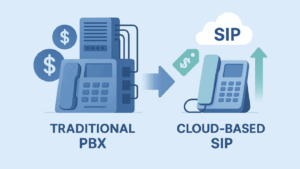
SIP Trunking vs. the PSTN: The Evolution of Today’s Communication Systems
The public switched telephone network (PSTN) includes all the world’s circuit-switched telephone networks operated by local, regional, or national telecommunications carriers. It is the basis for all public telecommunications. PSTN comprises telephone lines, transmission links, telephone cables, cellular networks, and more, enabling any telephone in the world to call any other.
Given all that, you might be surprised that AT&T and other major telephone carriers want to get rid of it. So what is PSTN’s status today? And what does this mean for business owners seeking better communications networks for their daily operations?
Trouble in Paradise
For decades, PSTN-based calls have provided the backbone that makes business possible for AT&T and other telecommunications providers. What is PSTN’s value to them now, as communications technologies rapidly shift?
Tier-1 carriers like AT&T state that it’s becoming more difficult and expensive to maintain, update, and service PSTN equipment. They see the future in technologies like SIP trunks, and they’re diverting investments away from the “plain old telephone service” (POTS) and towards fiber optic infrastructure.
Many carriers have already announced that their POTS maintenance and infrastructure contracts will quickly terminate and not be renewed. They’ve begun taking significant steps in that direction as of August 2022. These developments have been steadily underway since VoIP’s infancy, and today, Tier-1 providers are increasingly phasing out copper lines in ways affecting all consumers.
While this momentum has been commonly reported as due to FCC (and other agency) regulations, it’s more accurately due to a deregulation of the markets surrounding POTS.
The FCC succinctly explained its reasoning in its 2019 Order 19-72A1:
[W]e find that the public interest is no longer served by maintaining these legacy regulatory obligations and their associated costs.
They also cited rising VoIP subscription rates — including a 104% rise in related residential VoIP services and a 300% rise between 2008 and 2017.
Fewer users are connected to landlines because consumers have shifted to mobile and digital voice services. The fact that there are fewer users does not decrease the cost of operating the network; it simply puts the onus on a smaller user base.
This drives up prices compared to digital technologies, even further reducing demand. Carrier investment will go where the demand is, and providers are moving away from analog voice products to digital services like SIP trunking.
Telecom Agency
With exceptions for essential services, telecom companies are no longer required by regulatory agencies to use copper lines, meaning they can now close down PSTN lines at their will. It’s possible that if the POTS were sustaining past revenue levels, companies would be more willing to keep it alive — but it isn’t.
At the same time, revenue interests in quickly decommissioning copper lines have spiked, such as 2022’s $42.45-billion “Broadband Equity, Access, and Deployment” (BEAD) program. It’s solely an issue of unprofitable POTS; the profit motive is simply different, and there are even global financial interests at play. Like the PSTN’s intricate web of copper lines, an interconnected patchwork of private industry and governmental interests drive these shifts.
Because all carriers rely on the same physical maze of copper lines, one company’s closure can easily affect other carriers. They each sell and resell access to their network portions back and forth. Traditional PSTN service costs are rising dramatically — and the products they will start selling will be based on fundamentally different phone technology.
Related: SIP Trunking 101: The Fundamentals
Making the Switch
Simply turning off the PSTN would be far too disruptive, but the groundwork for letting it go dark has predominantly already been laid. Since 2013, the FCC has encouraged AT&T and other carriers to start testing functional IP-based alternatives to the PSTN in specific localities under certain circumstances (more below).
Because the FCC can drop PSTN service anytime, concerns about public safety, rural access, affordability, and support for people with disabilities must be addressed. Carriers and public officials have a lot of incentive to make it happen, and predictions for its complete phase-out put the move to a completed all-digital infrastructure just years away (with the exact timing depending on the country).
In America, AT&T is determined to reduce half of its copper lines by 2025. By that same year, many European countries appeared well on their way to a 100% digital telephone system. Verizon warned all sales channels that discontinuation of POTS was possible as early as April 2022. By the end of the year, Verizon posted several dozen network disclosure notices throughout the East Coast.
Because these changes are driven by a combination of private industry and government motives, it’s impossible to say precisely what PSTN’s shelf life is for consumer and enterprise-grade services. Still, there’s no question that SIP trunking and other digital means of communication have replaced most PSTN telephone networks and will continue to do so.
VoIP experts are already positioned to help customers reduce costs and transition burdens while leveraging the increased features made possible with broadband-based calls.
What is PSTN’s Status?
It’s important to distinguish between PSTN calls and the entire PSTN infrastructure. The former is being mainly made obsolete — the latter isn’t. The internet relies on the PSTN, which includes the broadband infrastructure used to replace most copper lines and analog calls.
In addition to copper telephone lines (the POTS), PSTN infrastructure encompasses:
- Fiber optic cables
- Communication satellites
- Microwave transmissions
- Cellular transmissions
- Under-sea cables
When you read that services such as VoIP, SIP trunking, and unified communications (UC) are replacing PSTN, the landline telephone networks are being turned off. For SIP trunking to function, the networking capability of the PSTN broadband infrastructure is still necessary.
Where Is PSTN Headed?
There are efforts underway to replace terrestrial network infrastructure with satellite networks. Some companies are already using satellite-based networking capabilities. For regular businesses worldwide, though, the most long-term networked call-routing solutions will require replacing or modifying devices that operate on PSTN telephone networks.
The existing infrastructure requires more support to handle increased SIP trunking, VoIP (voice over IP), hosted PBX (cloud-based private branch exchange), and other UC technologies. That infrastructure will be different and oriented towards expanding internet usage.
Broadband Infrastructure
Various means have been employed to reduce the impact broadband infrastructure engineering has had on public spaces. Throughout the late ’90s and the early 2000s, broadband infrastructure expanded parallel with copper phone line maintenance.
“Dig once” policies in some locations have required utility companies to coordinate with local ISPs so broadband expansion could seamlessly piggyback off utility or road work. So-termed “dark” (i.e., extra) conduits have also been laid to accommodate future capacity.
Efforts to shift communications to the internet have been underway for a long time. Much of this was done through legislation, such as the government’s Infrastructure Investment and Jobs Act and FCC preemption of local zoning. This is because new microcell technologies have a shorter range than earlier cellular solutions, which require more towers to be built.
The future of PSTN-turned-broadband infrastructure is mainly determined at the boundary between local and federal agencies, meaning its full scope needs to be 100% clear. At the same time, the ubiquitousness of the internet in daily life clearly indicates how ingrained SIP trunking and similar internet-based communications will also become as UC adoption rates increase.
Related: 10 Signs You Should Invest In a SIP Trunk
How Will Digital Communication Change?
This will vastly change the way global communications occur and make numerous features that used to be novelties commonplace, including:
- Video calls
- Fax-to-email
- SMS-to-email & email-to-SMS
- Automatically compiled call records
- Virtual DID (direct inward dialing)
- Instantly scalable telephone networks
- Multi-carrier integration
- Software integrations
- Central control interface
Further, there’s no longer a need for physically setting up telephone networks. If a SIP trunking provider allows BYOD (bring your own device) support, new users can simply sign up just as they would with any internet service. Those who prefer the formal utility of dedicated equipment, such as in an office, can also upgrade their devices to function through their internet connection.
Virtually Limitless
It’s all possible by connecting a location’s existing private branch exchange (PBX) equipment to the internet. Because phone calls have long been digitized, applying those signals in an almost entirely digital environment is now possible — and it’s driving radical shifts in how communications generally can be managed.
Organizations can achieve the most significant benefits of internet-based telephone routing through SIP-enabled PBX, which a SIP-trunking specialist with direct Tier-1 access can apply most comprehensively. Adaptability to the broadest range of telephony services is key to exercising the greatest choice over new network communications, of which voice calls are only the beginning.
SIP.US provides SIP-trunking solutions to businesses at any scale. If you’re interested in how SIP trunking will work with your existing network and communications systems, get started today with a free trial. Your communications needs never had so many solutions.


